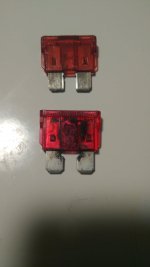Ianhill
1 MW
- Joined
- Sep 25, 2015
- Messages
- 2,874
Agu fuse holders I've been using at 60v 16s lipo with a 60amp fuse running 57amp and it holds with no nonsense tripping, I've not accurately blown one I just placed it with the neutral on and flashed the live to it and dead shorted 2 of them with my pack so i could physically disconnect and stop a Lipo fire if an arc did occur and it just blew the pants off them with no issue, I also used the maxi blades at 48v 40amp with no probs and done same with them.
I always tend to design my system so the fuse is the weak spot running around 90% capacity and the wire around 60-70% loaded to keep heat in the conductors to a minimum and allow breathing room in a fault to have low resistivity and deliver a strong short circuit current and activate the fuse fast, most fuses are rated around 110% of their design current and the stronger the surge the quicker the disconnect but the fuse itself needs to be able to extinguish the arc with normally a distant the voltage can not jump and then sand as an added measure in case the system goes outside it's voltage design limits which is highly unlikely with a battery system so you see mostly open air fuses on systems under 48v or classes as a non danger to life but will still hurt if you shove them on your tongue so if the agu fuse did blow don't go putting your thumb inbetween the contacts depending on your resistivity and voltage potential with the item current may flow and a dc shock can hold you on and burn you bad so only play if you have signed a waver with yourself no complacency.
I always tend to design my system so the fuse is the weak spot running around 90% capacity and the wire around 60-70% loaded to keep heat in the conductors to a minimum and allow breathing room in a fault to have low resistivity and deliver a strong short circuit current and activate the fuse fast, most fuses are rated around 110% of their design current and the stronger the surge the quicker the disconnect but the fuse itself needs to be able to extinguish the arc with normally a distant the voltage can not jump and then sand as an added measure in case the system goes outside it's voltage design limits which is highly unlikely with a battery system so you see mostly open air fuses on systems under 48v or classes as a non danger to life but will still hurt if you shove them on your tongue so if the agu fuse did blow don't go putting your thumb inbetween the contacts depending on your resistivity and voltage potential with the item current may flow and a dc shock can hold you on and burn you bad so only play if you have signed a waver with yourself no complacency.





